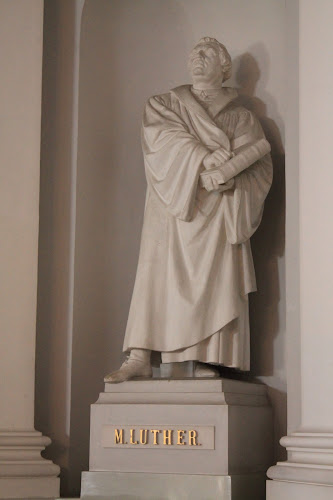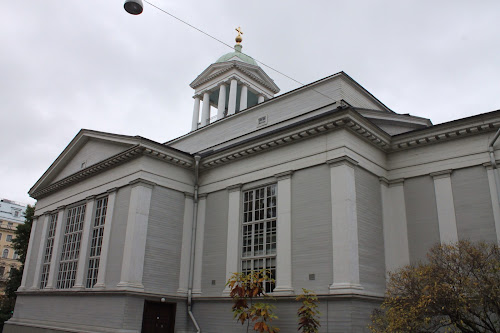Die nächste Station ist der Felsendom, eine in der 60er Jahren erbaute, oder besser in den Felsen gesprengte Kirche. Der Abraum, der durch sie Sprengung entstand, wurde auch gleich mit verbaut, für das Dach wurde eine viele viele Kilometer lange Rolle Kupferdraht in Runden gewickelt und oben oben drauf gesetzt. Von oben sieht es aus wie ein Auge oder wie ein Ufo, aber irgendwie freundlich, und innen ist sie schön und die Akustik ist phantastisch. Oftmals finden hier Konzerte statt.
Weiter geht es, zurück in das Stadtzentrum und dort gibt es eine Holzkirche, ein Provisorium, und wie jedes Provisorium hält sie länger, als ursprünglich geplant. Sie war der Versammlungsort der lutherischen Gemeinde, bevor der Dom fertig gestellt wurde. Der Dom ist nun schon lange geweiht, aber irgendwie sah niemand einen Grund, die Holzkirche abzureißen. Heute ist sie sehr beliebt für Hochzeiten.
Und zum Schluss kommen wir an der russisch-orthodoxen Kirche vorbei, der Usurpinski Kathedrale, ein neugotischer Backsteinbau mit den obligatorischen Zwiebeltürmen, die gar nichts mit Zwiebeln zu tun haben, sondern Symbole für Flammen sind, wobei die größte Flamme Jesus symbolisiert, uns die 12 kleineren die Apostel. Die Kirche hat Nikolaus II. bezahlt für dir russische Gemeinde der Stadt, den Helsinki gehörte 120 Jahre zum Zarenreich, bis das Land 1917 seine politische Unabhängigkeit erlangte.
Going by bus in the sunshine, the best sightseeing tour, I ever made. A nice voice, interesting, funny, charming comments and good background noises or music, all about the sights the bus just passes. We started a the cathedral, a classical monumental building, build after plans made by the german architect Engel, bright white in front of and azur blue sky,must be the place where the picture postcard heaven is produced. Inside the church is more simple, light colors, plain church benches, and the statues of Melanchthon, Luther and Agricola. Very imposant is the organ.
The next stop was at the Rock Church, build or better blasted out of the granite stone in the late 60s. The remains of the blasting where used to build the church and for the roof the used long long kilometres of copper, wich they turned in rounds and put it on top of the stones and the church was ready. It looks like an UFO or like an eye from above, but a friendly one, inside it is beautiful and got a great acoustic, so often concerts are held here.
Now back to the city center, there is a wooden church, a makeshift, and like makeshift always do, they last longer and longer. So did the church, it was made as a meeting center for the lutherian community before the cathedral was ready. After the cathedral was sacret, there was no reason to destroyed the church, so it's still there and very popular for wedding ceremonies.
In the end we came along the Russin orthodox church, the Uspenski cathedral. A neogotic building with the compulsive onion-domend towers, they got nothing to do with onions, but are a symbol of a flame, the biggest symbolises Jesus and the smaller ones are for the apostles. Nikolaus II paid for the church, a place for the orthodox community of Helsinki, wich belongs to the Russian Empire for 120 years until Finland became political independent in 1917.






































































